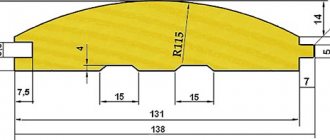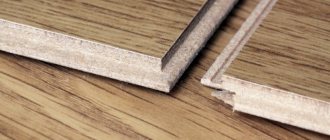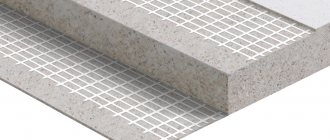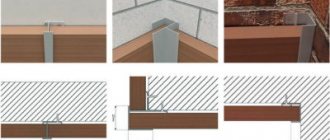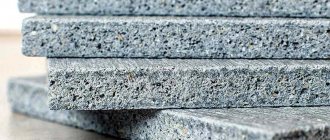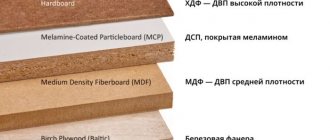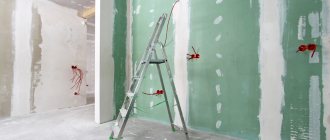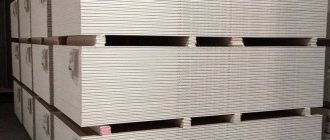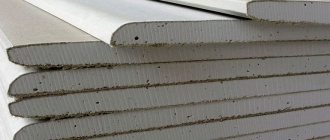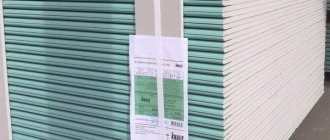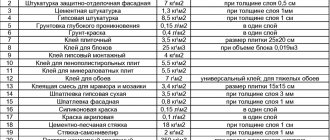What is chipboard?
Chipboard (officially chipboard, informally chipboard) is a sheet composite material obtained by pressing (0.2–5 MPa, 100–140 °C) wood shavings with urea or phenol-formaldehyde resin (6–18% of mass of chips). Widely used in the furniture industry, repair and construction work due to the relatively simple technological processes for obtaining the material and its low cost.
Attention! Officially, the abbreviation chipboard refers to wood-laminated plastic.
That. if you read the official document, then chipboard is a wood-laminated plastic. If you hear chipboard in colloquial speech, then most likely the interlocutor means chipboard, which will be discussed in this article.
Types of chipboard
There are several types of finishing and additional processing of chipboard, diversifying the range and improving the consumer properties of the product. The main types of wood-based products are the following:
- unpolished;
- carefully polished;
- covered with a layer of paper (laminated);
- veneered;
- laminated;
- waterproof;
- plates with increased fire resistance.
In addition to this, chipboard sheets differ in density and therefore have different specific gravity.
There are the first grade (without significant defects) of the material and the second (with some defects - chips, stains, unevenness). There are also slabs without grade, the most crudely made.
The range of all varieties is represented by a wide range of sizes, most of which are standard. If necessary, manufacturing enterprises are ready to offer chipboards for sale in the format specified by customers.
Unsanded products have the lowest prices and are used for rough work. The polished surface acquires a beautiful appearance and can serve as a decorative decoration. Often, after sanding, thick paper, veneer or polymer film is fixed onto the sheets.
Note! Laminated products (laminated chipboard) have increased resistance to external influences, have improved performance characteristics and are distinguished by decorative properties.
For lamination, the highest quality layers are chosen, which can be painted white, gray or any other color, imitate natural oak or mahogany, and have a variety of textures. The product is completely ready for use; the contractor only needs to cut out the workpiece of the required shape and size, process the edges and begin installation.
For cladding wet rooms and making furniture for rooms with a high concentration of water vapor, it is necessary to purchase moisture-resistant chipboard sheets, which additionally contain a paraffin component. The products have a higher cost than conventional products; the costs are recouped by long-term safe operation in difficult conditions.
For use in industrial situations accompanied by a significant increase in temperature, as well as in home kitchens, manufacturers provide the production of fire-resistant sheets. Increased fire resistance is achieved through additional impregnation of the chips with fire retardants. Fire-resistant modifications of chipboard are expensive, their use is justified when installed in conditions of high fire danger.
What is the difference from chipboard?
The basis of chipboards is wood chips, hot-pressed and pre-impregnated with inorganic resins. The surface structure of such a product is characterized by slight roughness and porosity.
To protect the chipboard surface from water and other adverse factors, as well as to give it an aesthetic appearance, the boards are coated with various materials. It can be veneer, paper, plastic, etc.
Melamine film is a special facing material . Chipboard laminated with it is called laminated particle board or laminated chipboard (see picture above).
Thanks to the melamine coating, laminated chipboard is mechanically stronger and superior to conventional chipboard in protecting against moisture, mold and other organic damage.
Take a look at the step-by-step instructions: a DIY coffee table made from chipboard.
What are chipboard and laminated chipboard
Chipboard is a composite material widely used in construction and furniture production. The boards are made from sawdust, which is put through a hot press and then impregnated with various additives and formaldehyde resins.
The surface of the slab becomes rough and porous. To protect the surface from moisture and give it an aesthetic appearance, the slabs are lined with veneer, paper, plastic and other materials.
Chipboards are classified according to the level of processing:
- polished (untreated);
- unpolished (processed);
- laminated;
- veneered;
- laminated.
Laminated chipboard is a board made of wood chips, which is treated with a laminated melamine film (laminated).
Advantages of laminated chipboard
Laminated chipboards have many advantages over chipboards. The main advantage of laminated chipboard is the protective melamine film.
Other advantages of laminated boards:
- strength (thanks to an additional layer - lamination);
- resistance to fungus and other types of bacteria;
- resistance to mechanical damage;
- emit less formaldehyde, a poisonous gas;
- aesthetically attractive appearance;
- variety of colors;
- heat resistance and ease of processing;
- do not require further processing or painting;
- in case of damage they are easily restored;
- high coefficient of heat and sound insulation;
- high wear resistance;
- low cost.
The beautiful appearance of laminated chipboards allows them to be used in the manufacture of furniture products, and the high parameters of heat and sound insulation make laminated chipboard an indispensable material in construction.
Flaws
Laminated chipboards are actively used today in the production of furniture products, but not in all types due to a number of negative characteristics.
Disadvantages of laminated chipboards:
- fragility during processing, inability to make curly cuts;
- insufficient moisture resistance and resistance to high temperatures;
- deep milling is contraindicated;
- formaldehyde fumes can harm human health;
- Long-term loads (more than 12 kg for 30 minutes) are contraindicated.
Conventions. How to decrypt correctly
Everything related to chipboard is set out in paragraphs of GOST 10632-2007 . Based on the quality of surface treatment, these products come in three grades: the first grade has the highest quality, and the third grade has the worst quality.
- First grade . Perfectly flat planes and the highest quality surfaces. On the basis of this grade, veneering, gluing or lamination, already known to us, is carried out, when the letter “L” is added to the abbreviation of the material.
- Second grade . Minor geometry deviations and surface defects are acceptable. This grade of particle board is used for making furniture, finishing cladding or forming a subfloor.
- Third grade . Rejection of 1st and 2nd grades. They have delamination throughout the slab, swelling of surfaces, scratches, and significant discrepancies in geometry. Sometimes unscrupulous sellers pass off the 3rd grade as the second, but more often slabs of this grade are shipped at a bargain price to construction sites for one-time work, for example, for the construction of formwork.
According to formaldehyde content
In the production of chipboards, phenol-formaldehyde resin is used, which can release substances hazardous to human health. Based on the content of this component, chipboards are divided into two classes :
- E1 - up to 80 mg per 1 kg of composite,
- E2 - up to 300 mg per 1 kg of material.
According to the European standard, the safest class will be Super E - this is an ultra-safe material that can be used in the construction and renovation of residential premises.
Physical and mechanical properties are indicated by the following symbol:
- PA has great bending strength, a smooth surface, is not afraid of moisture and almost does not swell;
- P-B has weaker characteristics compared to the P-A brand, but is cheaper, which explains their widespread use in construction.
According to the type of surface - with a regular and fine-textured ( M ) surface.
According to the degree of surface treatment - polished ( Ш ) and unpolished.
In terms of hydrophobic properties - with normal and increased ( B ) water resistance.
Decryption example:
P-A, 1, M, W, E1, 3500x1750x16, GOST 10632-89 Chipboard board grade P-A, 1st grade, with a fine-textured surface, formaldehyde emission class E1. Length 3500 mm, width 1750 mm, thickness 16 mm. Manufactured according to GOST 10632-89.
Chipboard varieties
Wood-based sheets are divided into three grades. Each of them has individual characteristics and indicators.
Chipboard varieties and their characteristics:
- the first is a flat surface without the presence of tubercles;
- the second - may have small scratches, peeling of the composite or pimples;
- third - they are characterized by uneven thickness, deep delaminations, cracks and scratches. In other words, this is a marriage.
What is better to use for furniture: MDF or chipboard?
The answer is simple - if the budget allows, then it is better to prefer the first. We talk about this material in more detail in a separate article. However, this does not mean that the laminated board has no right to life. We will talk about harmful substances and environmental friendliness below.
MDF and laminated chipboard are united by their base - natural wood. MDF is a fine wood fraction from which boards are made by hot pressing and subsequent drying. Before pressing, binders based on lignin and paraffin, which are harmless to humans, are added to the wood fibers.
Laminated chipboard is a simple chipboard modified by applying a layer of melamine resins and decorative paper to it under the influence of high temperatures, which gives it greater strength, moisture resistance and external beauty.
MDF is dense, so it is easy to process and use in the production of luxury furniture, which should be elegant and stylish.
Laminated chipboard is not so dense, but thanks to the protective film, it also resists high humidity and high temperature well. It is even used to make kitchen and bathroom furniture. Today, economy-class cabinet furniture is often made from laminated chipboard.
Key difference: the degree of environmental safety of MDF is such that its use has no restrictions; laminated chipboard (with the exception of the expensive Super E class) cannot be used in children's and medical institutions. Click here to view the MDF specifications in detail.
Which is better - laminated chipboard or MDF?
Laminated chipboard or MDF have many similar features. They are made from sawdust and cannot be distinguished by touch. But there is still a difference.
Chipboard (chipboard) consists of shavings passed through a hot press and impregnated with formaldehyde resins. The density of the chipboard sheet can be varied: from 300 kg/m3 to 600 kg/m3. More durable boards are more expensive and are used in the manufacture of furniture products.
Nowadays, manufacturers have learned to minimize the harmful effects of resin and improve the appearance of the material thanks to coating with melamine film. It performs a protective function, prevents the evaporation of formaldehyde and has a beautiful appearance.
MDF sheets are produced using advanced technology: by drying wood fiber and hot pressing. Medium-density MDF consists of only tiny shavings, pressed together until smooth.
Advantages of MDF boards
The main advantages of MDF:
- smooth and even surface (no need to pre-sand like chipboard);
- high density and strength;
- resistance to drilling and moisture (compared to laminated chipboard);
- better suited for deep milling and deformation when creating radius facades of furniture products;
- high environmental performance, since natural resins, lignin and paraffin are used to impregnate the chips;
- contains a much lower percentage of formaldehyde.
Since MDF is much more expensive than laminated chipboard, the best option would be to choose furniture with a combination of materials, that is, with the presence of laminated chipboard and MDF materials.
Laminated chipboard can be used as the basis for a kitchen, and MDF with a huge range of films can be used to decorate kitchen interior facades. High-quality laminated chipboard in combination with MDF can be used in the manufacturing process of other furniture products, such as cabinets, sofas, furniture groups for children's rooms.
If the manufacturer has the appropriate certificates that confirm the harmlessness of the material, then such furniture is safe to use and deserves the attention of consumers.
Standard sizes. Cutting in production
Chipboard sheet
The linear dimensions of chipboard panels are also regulated by the above GOST. In particular, this standard defines:
- length - from 1830 to 5680 mm plus 16 intermediate discrete values;
- width – from 1220 to 2500 mm with seven intermediate discrete values;
- thickness - from 3 mm and more in increments of 1 mm .
| Size | Value, mm | Maximum deviation, mm |
| Thickness | From 3 or more with gradation 1 | ±0.3* (sanded slabs) −0.3/ +1.7 (unsanded slabs) |
| Width | 1220, 1250, 1500, 1750, 1800, 1830, 2135, 2440, 2500 | ± 5,0 |
| Length | 1830, 2040, 2440, 2500, 2600, 2700, 2750, 2840, 3220, 3500, 3600, 3660, 3690, 3750, 4100, 5200, 5500, 5680 | ± 5,0 |
The permissible inaccuracy in the length and width of a chipboard panel is ±5 mm , thickness (sanded chipboard) ±0.3 mm . Unsanded chipboard has a thickness increased by an allowance of no more than 1.5 mm . At the request of the customer, the manufacturer can make sheets of other sizes.
Along with the dimensions, the standard specifies the perpendicularity of the edges, which cannot be more than 2 mm per 100 cm of edge. This error is established by measuring the diagonals of the sheet, the length of which should not differ by more than 0.2% .
Chipboard sheet
Linear geometry is determined only by the capabilities of the production equipment, since there is still no general standard for products of this type. You can focus on the dimensions of the non-laminated sheet, which are given above. Or the following popular sizes: 3.5 x 1.75; 2.44 x 1.83;2.5 x 1.83;2.62 x 1.83;2.8 x 2.07;2.8 x 2.62 m .
The thickness of laminated chipboards ranges from 8 to 38 mm . It is possible to produce thicker sheets, but they are rarely used and are not widely used.
Popular thicknesses
8 mm . They are used for wall cladding, door cladding, decorative furniture elements or as drawer bottoms, packaging production, and shipping boxes.
16 mm . Found its application in furniture production, construction of internal partitions, arrangement of subfloors
18 mm . Used for the manufacture of wardrobes and other cabinet furniture, mounted as a base for floor coverings.
20 mm . As a rule, they are used for installing subfloors.
22 mm . Widely used for the production of kitchen sets, countertops, chairs, tables.
25 mm . Thick sheets are used for the manufacture of window sills, doors, and various load-bearing elements of commercial structures.
32 mm . All of the above elements are designed for high load.
38 mm . Particularly thick chipboards are relevant in the production of solid bar counters and durable kitchen countertops.
Thickness and area of application
For a certain type of furniture products, boards of different thicknesses are used in production. The choice depends on the item, its operating conditions, load size and other conditions.
Depending on the composition of the chipboard layer, there are different types:
- single-layer;
- two-layer;
- three-layer;
- multilayer.
The material consists mainly of three layers. The outer part contains small chips, the inner part contains larger ones.
Thickness parameters, and in which products they are used:
- from 8 to 10 mm - used in the manufacture of products that will not be subjected to heavy loads (decorative partitions, drawers, furniture panels and facades);
- from 16 to 18 mm - used for making furniture and laying floors (linoleum or laminate);
- from 22 to 15 mm - used to create products with medium load (kitchen tables, doors);
- from 28 to 38 mm - used in the manufacture of structures with special loads (shelves, countertops, bar counters).
The standard chipboard thickness for furniture is 16-18 mm.
The thicker the product, the more loads it can withstand. It should be noted that thin slabs are more flexible than thick ones. Under high loads, they break faster than thin ones. The thickness of the slabs also affects hardness. The greater the thickness of the material, the less its hardness.
Other important parameters
Sheet weight (kg)
| Thickness, mm | Format, mm | ||||
| 2440x1830 | 2750x1830 | 3060x1830 | 3060x1220 | 3060x610 | |
| 8 | 26,0 | 29,4 | 32,7 | 21,8 | 10,9 |
| 10 | 32,6 | 36,7 | 40,8 | 27,2 | 13,6 |
| 12 | 39,1 | 44,0 | 49,0 | 32,7 | 16,3 |
| 16 | 52,1 | 58,7 | 65,3 | 43,5 | 21,8 |
| 18 | 58,6 | 66,0 | 73,5 | 49,0 | 24,5 |
| 26 | 84,6 | 95,4 | 106,1 | 70,8 | 35,4 |
Density, kg/m3
| Density, kg/m3 | Thickness | |||||||
| 8 mm | 10mm | 16 mm | 20 mm | 22 mm | 30 mm | 32 mm | 38 mm | |
| 740 | 720 | 680 | 670 | 660 | 620 | 600 | 600 | |
Volume and area of sheets
| Thickness, mm | Length, mm | Width, mm | Sheet volume, m3 | Sheets in 1m3, pcs. | M2 in 1 sheet | *Sheets per pack | |
| std. | n/st | ||||||
| 8 | 2440 | 1830 | 0,036 | 27 | 4,47 | 90 | |
| 2750 | 1830 | 0,040 | 25 | 5,03 | |||
| 3060 | 1830 | 0,045 | 22 | 5,60 | |||
| 3060 | 1220 | 0,030 | 33 | 3,73 | |||
| 3060 | 610 | 0,015 | 66 | 1,87 | |||
| 10 | 2440 | 1830 | 0,045 | 22 | 4,47 | 85 | |
| 2750 | 1830 | 0,050 | 20 | 5,03 | |||
| 3060 | 1830 | 0,056 | 18 | 5,60 | |||
| 3060 | 1220 | 0,037 | 27 | 3,73 | |||
| 3060 | 610 | 0,019 | 52 | 1,87 | |||
| 12 | 2440 | 1830 | 0,054 | 18 | 4,47 | 72 | |
| 2750 | 1830 | 0,060 | 16 | 5,03 | |||
| 3060 | 1830 | 0,067 | 15 | 5,60 | |||
| 3060 | 1220 | 0,045 | 22 | 3,73 | |||
| 3060 | 610 | 0,022 | 45 | 1,87 | |||
| 16 | 2440 | 1830 | 0,071 | 14 | 4,47 | 54 | 35 |
| 2750 | 1830 | 0,081 | 12 | 5,03 | |||
| 3060 | 1830 | 0,090 | 11 | 5,60 | |||
| 3060 | 1220 | 0,060 | 16 | 3,73 | |||
| 3060 | 610 | 0,030 | 33 | 1,87 | |||
| 18 | 2440 | 1830 | 0,080 | 12 | 4,47 | 48 | 31 |
| 2750 | 1830 | 0,091 | 11 | 5,03 | |||
| 3060 | 1830 | 0,100 | 10 | 5,60 | |||
| 3060 | 1220 | 0,067 | 15 | 3,73 | |||
| 3060 | 610 | 0,036 | 27 | 1,87 | |||
| 26 | 2440 | 1830 | 0,116 | 8 | 4,47 | 36 | 21 |
| 2750 | 1830 | 0,131 | 7 | 5,03 | |||
| 3060 | 1830 | 0,146 | 6 | 5,60 | |||
| 3060 | 1220 | 0,097 | 10 | 3,73 | |||
| 3060 | 610 | 0,049 | 20 | 1,87 | |||
Classification
One of the first parameters that people pay attention to is the type of surface treatment. There are 2 options: sanded and unpolished slabs. They differ in the quality of the coating, which determines the area of application of the material. In addition, the slabs are distinguished by structure:
- ordinary (designated by the first letter – O);
- fine-textured (M).
The second option is used in the production of laminated boards. This is due to the fact that the film adheres better to the surface of such a product.
Surface quality
Slabs of different types are produced, differing in the number of defects:
- 1st grade – without changes in the structure of the material, defects;
- Grade 2 – a certain amount of damage is acceptable (regulated by regulatory documentation).
Due to average strength and moisture resistance, chipboard with more significant defects is not used, since it will not perform its main functions. The service life of the material will be significantly reduced.
Emission class
There are types of stoves that differ in the degree of danger to human health. They contain varying amounts of toxic components (in particular formaldehyde):
- E0.5;
- E1;
- E2.
Is chipboard harmful?
If you need to use the material indoors, only the first two options are considered. The concentration of formaldehyde in the structure of the binder component and when released into the surrounding space is minimal and is considered acceptable. However, the rule here is: the less, the better, so option E0.5 is preferable.
Strength level
There are types:
- P1 – general purpose;
- P2 – products intended for the manufacture of furniture and finishing work indoors.
The second option is more durable, so the scope of application of the slabs of this group is wider. P1 products are more often used for rough finishing, temporary structures or as auxiliary material. The strength of chipboard varies: 550-750 cubic meters. m. At the same time, the range of density values is also different: 0.5-1.0 g/cubic. see. Tensile strength is also taken into account:
- when bending – 10-25 MPa;
- when stretching - 0.2-03.5 MPa.
How to paint
Our material is beautifully painted and in one evening even from a shabby and unsightly piece of furniture you can create such beauty:
When painting, you should be guided by the principles that will be relevant when working with ordinary wood:
- Preparing the surface. Using a sander or sandpaper we get rid of the old coating.
- Before painting, if there are deep scratches and holes on the surface of the chipboard, you cannot do without putty and subsequent sanding. Failure to perform these operations will result in minor defects appearing on the painted and dried surface, and the work will look untidy. The putty should be applied in an even layer using a spatula. After drying, the putty layer is sanded until the surface is completely level.
- We clean the surface from dust and other by-products from the previous paragraph. Degrease with white spirit or acetone.
- We apply primer. This improves adhesion and reduces paint consumption.
- And finally, the most interesting part - coloring! We recommend any acrylic paint.
Paint is applied to chipboard in several layers, and their number is determined by the porosity of the surface and the qualifications of the artist. After the first coat of paint is applied, the shortcomings of the pre-treatment often become more apparent. In this case, it is useful to go over the chipboard again with fine-grit sandpaper and apply a second coat of paint.
Rules for painting chipboard
Before painting the slab, you need to decide on the paint.
The following types of paints are used to paint chipboard:
- Acrylic - must be applied to the prepared surface. Due to its water base, it is quickly absorbed.
- Latex - protects against moisture, but their cost is very high and they are difficult to remove.
- Alkyd - can be applied without a primer, but in this case it is worth stocking up on a large amount of paint.
- Stain - used for impregnation and creating a certain texture. Excellent for laminated chipboards.
- Varnish - a colorless version is used to protect the surface.
- Spray paint is suitable only for decoration, as it is not capable of painting a large surface.
Painting must begin with a primer. To do this, acrylic compounds are used, with which several layers of material are impregnated. After applying the paint, you must wait until it dries completely.
Coloring stages:
- The paint must be applied with a roller or spray gun. Hard-to-reach places are painted with a brush. If painting is carried out without priming, you can thin the paint a little.
- The coloring composition must be evenly distributed over the surface in one direction. Apply 2 to 5 times. Spraying can be used, but this is a more complex process.
- After the last coating has completely dried, varnish can be applied as additional protection.
Harmful substances. Chipboard and your health
Let's not beat around the bush. The material we are talking about emits a volatile compound that is toxic to humans - formaldehyde. Most likely, the concentration of toxic substances in your new piece of furniture will be uncritical and insignificant compared to other anthropogenic environmental factors that harm humans. However, there is no 100% guarantee and it is hardly possible to check it yourself, since accurate measurements are only possible in a special laboratory.
Actually, for this reason, there is no single consumer opinion regarding the use of chipboard in everyday life. Some say it's completely harmless. Others say that it is harmful only for the first 1-2 years. Still others, on the contrary, argue that with age, furniture “fones” even more strongly, as the resins will decompose...
Material calculation
To determine the required quantity of products, the scope of application should be taken into account:
- Wall covering. The width and height of the surface are measured, and a suitable wood-based material is selected. The simplest option is to calculate the area. If the base dimensions are 5 m and 2.5 m, then the area will be 12.5 m2. The sheet dimensions are 183 and 275 cm, so the area of one fragment is 5 m2. 12.5/5 = 2.5 (3 whole panels).
- Floor covering. The most effective, but very painstaking method is drawing up a diagram. To do this, the width and length of the horizontal structure are measured, and the data is transferred to the drawn plan. Next, based on the possible dimensions of the chipboard sheet, the material is adjusted. This will allow you to take into account all the nuances and avoid unnecessary trimming.
- Furniture manufacturing. This is a responsible job that requires skills. If the interior item is made according to individual parameters, then a detailed drawing is drawn up. Then the dimensions of each part are sequentially determined, taking into account its location in relation to other elements. All obtained dimensions are transferred to the cutting program, which allows you to accurately determine the required number of slabs.
To work with chipboards, high-quality high-speed tools are used.
Chipboard is perfect for creating furniture and lining the interior surfaces of a house, which is explained by the availability and good quality of the material.
Is chipboard harmful to health?
The main harm to human health is formaldehyde , the emission of which from stoves can continue for several years.
Depending on the product category for the release of formaldehyde, GOST directly indicates the scope of application:
- E 0.5 - for furniture, including those intended for children's and school institutions;
- E 1 - for any furniture, except for those intended for rooms with children;
- E 2 – for various products, except any furniture.
The best environmental friendliness is inherent in the E0.5 category; you should avoid using products with the E2 index in everyday life, despite the low price.
How chipboard is made
Non-commercial wood and almost any wood waste generated during any processing, starting with tree felling, are suitable for making chipboard:
- substandard round timber and branches;
- slabs, remains from edging boards, trimmings;
- wood chips, shavings, sawdust.
Production consists of several stages.
Preparation of raw materials
Lump waste is crushed into chips. From chips and large shavings, shavings of the required sizes are made: thickness from 0.2 to 0.5 mm, length 5-40 mm, width up to 10 mm.
The round timber is cleared of bark, cut into measured pieces, usually 1 m long, and after soaking, it is split along the fibers into small fragments, followed by grinding to the desired condition.
The plate has a three-layer structure. The outer layers are made from small chips, and the core is made from larger ones. Therefore, the mass of chips is divided and the part intended for the outer layers is further crushed. After drying, sorting occurs. Using sieving, unsuitable fractions are separated and redistributed, and too large chips are returned for grinding.
Molding and pressing
The prepared chips are mixed with synthetic resin, which is included in the chipboard as a binder. This operation is carried out in a special machine, where the resin is sprayed into small drops and settles on the surface of wood particles “suspended” in the air flow. This mechanism allows you to cover the entire surface of the chips with glue and prevent excess resin consumption.
The resinous chips enter the dispenser, which places them on a conveyor belt or pallet, forming a layer of a given thickness. Three layers are laid sequentially, in accordance with the three-layer chipboard structure. The resulting “carpet” is divided along its length into standard size packages and fed into a vibrating press for preliminary compaction. After preliminary pressing, briquettes are obtained that can withstand movement into the main hydraulic press.
Before pressing, the briquettes are heated to 75°C using microwave radiation. In the press they are exposed to a temperature of 150–180°C and a temperature of 20–35 kgf/cm2. Under pressure, the material is compacted, and heat causes the binder to harden.
Full readiness
After pressing is completed, the finished chipboard sheets are cooled by air currents, then stacked and left for several days. During this time, the temperature in the material gradually equalizes and internal stresses are relieved.
Before the material is completely ready, the surfaces are polished and cut into sheets of a given format. They are then labeled and packaged for shipment to the consumer. When producing furniture or facing boards, a lamination stage is added to the technological chain.
Main characteristics of chipboard
Strength and density of chipboard
The strength of chipboard is determined by its belonging to one of two groups - P1 or P2. P2 slabs have higher bending strength - 11 MPa versus 10 MPa for the P1 group. They are almost one and a half times more resistant to delamination. The density of sheets of both groups is 550 – 820 kg/m3.
One aspect of strength is the ability to hold fasteners. A screw screwed into the face of the slab can withstand a pull-out load of 3.5 to 5.5 kg per millimeter of length. When installed at the end, the maximum force is less - 3.0-4.5 kg/mm.
| Index | P1 plate | P2 slabs |
| Density, kg/m3 | 550-820 | |
| Impact strength, J/m2 | 4000-8000 | |
| Hardness, MPa | 20-40 | |
| Specific resistance to pulling out screws, N/mm, from the plastic | 55-35 | |
| Specific resistance to pulling out screws, N/mm, from the edge | 45-30 | |
Moisture resistance of chipboard
The resistance of chipboard to moisture is not regulated. This material is intended for dry conditions only. Although there are moisture-resistant versions of it, which are produced with the addition of a water repellent.
Biological resistance
The biological resistance of particle boards is quite high. They are not damaged by insects, and fungus does not take root on them. The slab may completely collapse from moisture, but there will be no rot on it.
Fire safety
When assessing the fire hazard, chipboard should be considered as wood. The composite belongs to the same flammability group G4, although it does not catch fire and spread fire as readily as wood.
Environmental friendliness
Chipboard is quite safe for people, but when using it, you need to pay attention to the emission class, which depends on the level of formaldehyde released into the air. Material of class E2 cannot be used inside residential premises; slabs of class E1 are intended for this. For children's rooms, schools, kindergartens, nurseries, and hospitals, slabs of class E0.5 should be used, which contain a very small amount of formaldehyde and their effect on the composition of indoor air is negligible.
Thermal conductivity
The thermal insulation qualities of chipboard are low, but they should be taken into account when using it as wall, ceiling or floor cladding. The average thermal conductivity of the slabs is 0.15 W/(m∙K). With a thickness of 16 mm, the thermal resistance of the skin per square meter of area will be 0.1 (m2∙K)/W. For comparison: a wall made of ceramic bricks 390 mm thick has a thermal resistance of 2.22 (m2∙K)/W, and a layer of mineral wool 100 mm thick has a thermal resistance of 0.78 (m2∙K)/W. And yet, chipboard sheathing, especially together with the air gap behind it, can become a noticeable addition to insulation.
Vapor permeability
Water vapor permeability is an important characteristic of chipboard if it is used in external building envelopes. With a permeability of 0.13 mg/(m∙h∙Pa), the material cannot serve as a vapor barrier, but when cladding the outside, good vapor permeability will help remove moisture from the wall.
What it is?
MDF got its name from the English abbreviation MDF, which translated into Russian means “finely dispersed fraction”. Explanation LDSP - laminated chipboards. Materials are manufactured using different technologies, which is why they have different properties.
laminated chipboard
This is a regular particle board (chipboard) covered with a laminated film. The main raw material for its production is waste from wood processing enterprises. It can be:
- crooked trunks;
- knots;
- branches;
- trimmings generated during the process of sawing logs and trimming lumber.
The wood is cleared of bark and fed to grinding units, for example, rotary knife grinders. This is how shavings are made. Its average thickness is 0.5 mm, width is no more than 5 mm, and length is about 40 mm.
During the production process, the chips are dried in special chambers and then calibrated. After preparation, the raw materials are fed into mixers that operate continuously. There it is mixed with binders. The next stage is the entry of the viscous mass into the molding equipment, which forms a 1-3-layer carpet. It goes to pressing. When compressing the workpiece, a pressure of 40 kg/cm3 and a temperature of up to 220 degrees are applied.
The slabs formed and dried in this way enter the cooling chambers. After this, the edges of the material are aligned and cut to the specified dimensions. Particle boards are sanded, making them even and smooth.
The next stage is lamination. It is performed in a certain sequence:
- gluing 1-2 layers of paper onto the base (the first should have a maximum thickness of approximately 0.5 - 1 mm, so that in the future it will be possible to press the design);
- laying a layer of transparent paper and mixed resinous substances;
- applying the main layer to the chipboard slab and pressing it with a stamp with a pattern; gluing the decorative layer is done in the same way;
- gluing with a stamp a protective layer that protects the product from various contaminants.
When exposed to high pressure and temperature, the film reliably adheres to the board, forming a durable laminated coating.
MDF
For the production of MDF boards, the raw materials are prepared in the same way as for the production of laminated chipboards.
- Wood chips are made from wood waste and dried to a moisture content of 9%.
- Next, it enters special cyclones, where large chips are sifted out due to air separation.
- The calibrated chips are heated and pressed under high pressure.
- In the process, due to the strong heating of wood fibers, natural resins (lignin) are released. Thanks to these substances, the chips are firmly glued to each other.
- The MDF boards obtained after pressing are cooled and ground to give a smooth surface.
- After this, the products undergo further processing - they are sanded, laminated or varnished.
Manufacturers also produce more expensive material – veneered. It involves gluing a thin layer of natural wood onto the surface of the slabs.
Chipboard GOST
The chipboard production technology, physical and chemical parameters, operational characteristics and other aspects are regulated by the following regulatory documents:
| № | GOST | Name |
| 1. | GOST 18110-72 | Particle boards. Technology. Terms and Definitions |
| 2. | GOST 11842-76 | Particle boards. Method for determining impact strength |
| 3. | GOST 11843-76 | Particle boards. Hardness determination method |
| 4. | GOST 10632-77 | Particle boards. Specifications |
| 5. | GOST 10633-78 | Particle boards. General rules for preparing and conducting physical and mechanical tests |
| 6. | GOST 10637-78 | Particle boards. Method for determining the resistivity of pulling out nails and screws |
| 7. | GOST 23234-78 | Particle boards. Method for determining the specific resistance to normal tearing of the outer layer |
| 8. | GOST 25885-83 | Glued wooden structures. Method for determining the strength of adhesive joints between wood-based materials and wood |
| 9. | GOST 10634-88 | Particle boards. Methods for determining physical properties |
| 10. | GOST 10635-88 | Particle boards. Methods for determining the tensile strength and elastic modulus in bending |
| 11. | GOST 27678-88 | Particle boards and plywood. Perforator method for determining formaldehyde content |
| 12. | GOST 27680-88 | Particle boards and wood-fiber boards. Size and shape control methods |
| 13. | GOST 27935-88 | Wood-fiber and particle boards. Terms and Definitions |
| 14. | GOST 10632-89 | Particle boards. Specifications |
| 15. | GOST 10636-90 | Particle boards. Method for determining the tensile strength perpendicular to the plate face |
| 16. | GOST 52078-2003 | Particle boards lined with films based on thermosetting polymers |
| 17. | GOST 32289-2013 | Particle boards lined with films based on thermosetting polymers |
Laminated chipboard - sheet size, thickness and cost of material, manufacturers
EGGER laminated chipboards have the following characteristics:
| Chipboard size, mm2 | Chipboard thickness, mm | Quantity per pallet | Pallet gross weight, t | Weight of one sheet, kg | Density, kg/m3 | Emission class |
| 2070*2800 | 8 | 24 | 1,13 | 47 | 660-670 | E-1 |
| 16 | 24 | 1,64 | 63 | |||
| 25 | 14 | 1,40 | 94 |
For detailed information on prices, see the price list page.
Features of laminated chipboards
Laminated chipboards are produced exclusively from high-quality polished chipboards in accordance with GOST 10632-2007. They do not have the disadvantages inherent in other particle boards: they are durable, resistant to steam, mold and moisture, chemical and mechanical stress, and a special melamine film and edge finishing significantly reduce the level of hazardous fumes and increase the wear resistance of the material.
Thanks to these characteristics, laminated chipboards can be used for the manufacture of furniture and interior decoration, including kitchens, hallways and bathrooms, wardrobes, office and children's furniture, and as flooring.
Laminated chipboards are presented on the market in a huge number of colors and textures, allowing you to imitate any material, including stone, marble, metal or fabric, and fit into any color scheme or interior style at a very modest cost.
Laminated chipboards do not require further processing or painting. To make furniture facades and tabletops, it is enough to cut the purchased sheet of chipboard in accordance with the specified dimensions and edge the edges.
The surface of laminated particle board can imitate natural wood
Important! It is necessary to treat the edge not only to increase the wear resistance and appearance of the material, to protect it from moisture and steam, but also to prevent the evaporation of harmful substances.
However, this is the main disadvantage of this material - the need for a special machine for sawing laminated chipboards and edging them. However, at present, any hardware store or furniture manufacturing workshop provides such a service as cutting laminated chipboard to customer sizes.
Another disadvantage is that due to the crumbling edge, such slabs are also not suitable for creating curved contours and complex carved elements.
Furniture made from chipboard. Calculation.
I wanted to describe each point in detail, but I realized that there would be a lot of “water”, so ask any questions you have in the comments - I will answer all of them.
Also, I do not wish to replace the best master and do not want to offend anyone present here.
I will look at the furniture that is currently in my work in order to complement the picture with “live” photographs, proofs and show in more detail the assembly process.
!
I do all calculations only in millimeters.
So let's get started! We currently have the following cabinet at work:
Client – State institution. They usually choose everything cheaper and in standard colors.
I don’t see the point in drawing a new drawing every time, so I mainly discuss the issue with the image with the client in a notebook with a hand sketch.
A few words about chipboard.
We have three main suppliers:
EGGER – Usually the most expensive and highest quality;
Kronospan - Not much inferior in quality to EGGER and 20-30% cheaper in price;
Swisspan - The most budget option. This is what we will be looking at today. (Price in Ukraine:
450-500 UAH for our color)
People chose the color: Apple (In the picture) and thickness 16mm (The most common).
I haven’t yet said that chipboards come in two sizes: 2800x2070 and 2750x1830
We are interested in the second size.
Now we need to make a cutting map (This thing where they show how many of these chipboard sheets you need, the edge and how to cut)
I use Cutting3 because it's convenient for me. (Yes, yes, I tried Pro100, and Basis, and other programs, but this is the most convenient for me. And the simplest.)
On the left side (in the picture above) we enter our sheets, where:
1 – The material from which we make our cabinet (Actually, this point is not so important in this program);
2 – Dimensions of our sheet;
3 – The number of sheets that we need (We can immediately set it to 999, the program will then show itself exactly how much we will spend on the order);
4 – This is the width of the saw cut and it is advisable not to touch it.
5 – This is sawing the sheet to make a right angle and remove chips. You need to put it like this:
For cutting, take from 5 to 15mm, in our case we took 10mm. This is the norm.
Please note that if the cabinet has fronts made of 16mm chipboard, then you must subtract 20mm from its total depth.
Let's say we need to find the depth and width of the top and bottom of our cabinet. The width remains unchanged - 600mm. And our depth will be 450mm – 20mm = 430mm. This is done in order to reach the size we need and so that there is a gap (Millimeters that will save us later).
Now we know our top and bottom, as well as our quantity:
We set it to “rotate” because the structure is not important to us.
Next we need to calculate the stand (side wall of the cabinet). We take the total size of 2200mm, subtract from it the thickness of the upper (16mm) part and the lower (16mm). And subtract the height of the legs.
Our leg is D-50:
A description of almost every leg can be found on the Internet, for every taste and color.
2200mm – 16mm – 16mm – 27mm = 2140mm (I round to 0, sometimes 1mm can save you.)) Now we know the height of the stand, and we ALREADY KNOW the depth of our cabinet. Adding to the details:
!
We do not rotate only the facades.
We can easily rotate everything else.
Next we must insert our shelves, of which there are 5 pieces (As in the picture). We take the total width of 600mm and subtract two 32mm racks. And that's all, guys!
Knowing the depth, we get a part 568x430 and fit it in. All the same.
And the last thing is the facades. The standard height of such facades is 720mm. There should be two of them. That is, we divide the width of 600mm in half and get 720x300x2, where 2 is the quantity.
BUT! The facades are glued with an edge of two millimeters around the perimeter, so on each side we have to take them away and another millimeter for the gaps (Then they will save us again). As a result, we must subtract 6 mm from the length and 6 mm from the width.
Main settings
Typically, laminate is sold in the form of rectangular boards of different sizes with a pattern of texture of a particular tree. These are the most popular and sought-after options on the market. But laminate slats are also available in the form of squares with various patterns on the surface, as well as in a single color to resemble metal or other material.
Laminate can be wide, medium and narrow
The laminate labeling on the package indicates:
- class for strength and abrasion resistance;
- formaldehyde emission level;
- type of connection of laminate boards;
- length, width and thickness for one lamella;
- number of pieces in the package and their total area.
The dimensions of the laminate directly affect the appearance of unnecessary trimmings during installation of the coating. If you take slats that are too wide or long, you will have to cut more of them near the walls. However, it is often impossible to use such residues elsewhere on the floor. All this goes to waste, and the money was paid for the overall square footage of the finish. This results in unnecessary expenses, which can be completely avoided by correctly calculating the volume of required material at the very beginning.
Marking on laminate packaging
Length
The most popular length among manufacturers is considered to be 126–138 cm. Laminate with a size within these limits is easy to transport and install. It is even easier to work with shorter boards, but transporting them is more difficult due to the larger number. You can also find narrow lamellas with a length of up to 2 meters in the store, but their installation is fraught with serious difficulties. For self-installation, this option is not worth taking.
The less you have to trim the laminate during installation, the more beautiful the assembled coating will look later. Plus, it is much easier to carry, try on the floor and cut boards that are just over a meter long than larger laminate plates.
For small rooms, it is recommended to take small slats. They will look more harmonious in the interior and not as cumbersome as their longer counterparts. The joints of individual elements of the laminate finish are only barely noticeable at first glance. After laying the covering, these seams and dimensions of the boards are still clearly visible on the floor.
Basic dimensions of laminate
Width
The width of the laminate is also not limited by any standards. The manufacturer himself decides what laminated products will be in his collection. Here, the pattern on the surface of the lamella and the overall design of the coating play an important role. The entire range of laminate flooring according to the width of the board can be divided into three groups:
- Narrow 90–160 mm.
- Average 160–195 mm.
- Wide – up to 350 mm or more.
The first ones are usually an imitation of narrow parquet planks. The latter are among the most common; the pattern of wood fibers on them looks as natural as possible. Third, this is often an attempt to create a copy of the tile, a kind of “laminated tile” for installation, for example, in the kitchen.
Thickness
The thickness of the laminate greatly influences the strength of the board and its durability. The thicker the lamella, the longer it retains its dimensions under loads and the more reliable the locking connections are. If you take an option that is too thin and place heavy furniture on top, the covering will inevitably and quickly sag under the legs of sofas or tables. And no heavy-duty substrate will save you here.
The following parameters are considered standard thickness dimensions for lamellas:
A number of manufacturers also produce cheap laminate with a very small thickness of 6–7 mm. But these products are practically not in demand among buyers. They provide a slight increase in height for the decorative covering, which is especially important if the screed is made thick or you had to use a high backing. However, this option is too soft and has low strength.
What thickness to choose laminate
If the thickness of the laminate exceeds 12 mm, then it is most often a moisture-resistant board belonging to class “33” or “34”. This coating can withstand high loads for many years without damage and is more resistant to wear.
At the same time, thick lamellas conduct heat worse. On the one hand, the floor decor made from them turns out to be more comfortable for walking barefoot, but on the other hand, it is impossible to install a “warm floor” under such a finish. In the second case, a significant part of the energy will be wasted on heating the wood, without benefiting the people in the room.
The weight of the lamella is affected not only by the size of the board, but also by the material and technology of its manufacture. The simplest case is when the load-bearing base is plywood. But laminate is a multi-layer cake. And there are products with additional layers of durable, moisture-resistant plastic and not plywood, but MDF or HDF.
Each of these options weighs its own kilograms. If this point is critical, then it should be clarified with the seller of a particular laminate and carefully look at the inscriptions on the packaging. The weight of the pack with boards must be indicated there.
